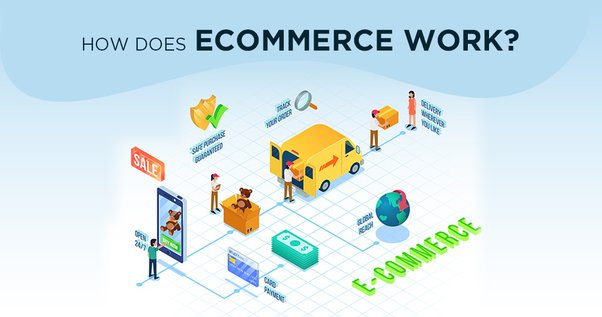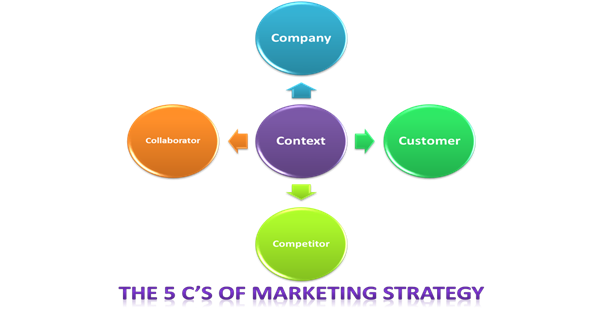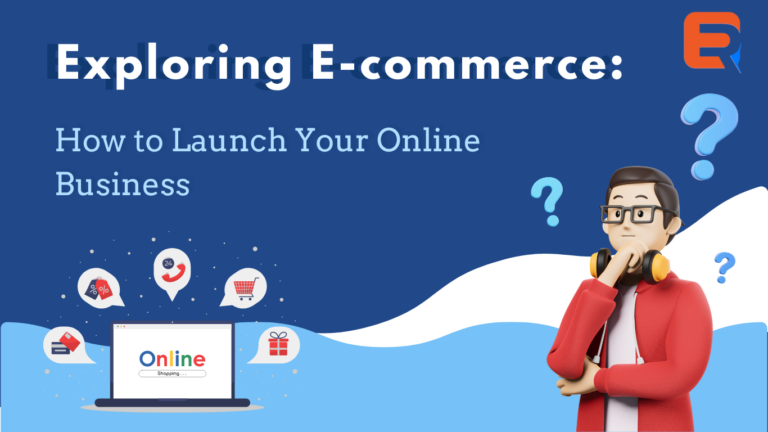It is a type of digital transaction where customers can purchase goods or services from businesses or individuals through online platforms. Ecommerce is rapidly growing in popularity due to the convenience, accessibility, and flexibility it offers to both consumers and businesses. From clothing and accessories to household goods, electronics, and even food, there are very few products that cannot be sold through ecommerce.
How Ecommerce Works?

Ecommerce works by allowing businesses or individuals to create online storefronts where they can sell their products or services. These storefronts can take many different forms, from simple websites to sophisticated marketplaces that offer a wide range of products and services. Customers can access these storefronts using their computers or mobile devices and can browse products or services, add items to their cart, and make purchases using a variety of payment methods. Once the purchase is complete, the business or individual ships the product or delivers the service to the customer, either through a physical delivery or a digital download. To facilitate these transactions, ecommerce relies on a variety of technologies and platforms. Efficient fulfillment centers play a crucial role in ensuring the smooth handling of orders and timely deliveries. They manage everything from inventory storage and order processing to shipping logistics, making them invaluable for businesses aiming to enhance their customer experience. Online storefronts are built using ecommerce platforms like Shopify, WooCommerce, or Magento, which provide businesses with the tools they need to create and manage their online stores. Payment processing platforms like PayPal, Stripe, or Square enable businesses to accept payments from customers securely and quickly. And shipping and logistics platforms like ShipStation, Shippo, or EasyPost provide businesses with the tools they need to manage shipping and deliveries. Types of Ecommerce There are several different types of ecommerce, each with its own unique characteristics and advantages. Here are some of the most common types of ecommerce: Business-to-Consumer (B2C) Ecommerce: This is the most common type of ecommerce, where businesses sell products or services directly to consumers. Examples include online retailers like Amazon, clothing stores like Zara or H&M, or service providers like Uber or Airbnb. Examples include construction companies bidding on government contracts, or software providers selling their products to government agencies. Advantages of Ecommerce Ecommerce offers many advantages to both businesses and consumers. Here are some of the key benefits of ecommerce: Convenience: Ecommerce allows consumers to shop from anywhere, at any time, without the need to visit a physical store. Access: Ecommerce allows businesses to reach a wider audience than they could with a physical store.
FAQs
What are the 4 types of e-commerce?

E-commerce is related to commerce, but differs in that it involves the use of the Internet and digital technologies. It has grown over the years, and increased in popularity as a result. E-commerce is not only used for online shopping, but also includes auctions, peer-to-peer marketplaces, and many other tools to facilitate a transaction between buyer and seller.
The four main types of e-commerce are: Business-to-consumer (B2C), Business-to-business (B2B), Consumer-to-consumer (C2C), and Consumer-to-business (C2B).
What are the features of e-commerce?

E-commerce has grown rapidly over the past couple of years, transforming the way businesses do business. These seven key features are what make e-commerce a powerful platform for businesses to connect with customers: ubiquity, global reach, interaction and personalization, information density .
E-commerce is a comprehensive approach to selling products and services over the Internet that can be used by every business. The term e-commerce was first used in 1990 and is defined as “the buying and selling of goods or services electronic commerce” (Merriam-Webster). E-commerce gives businesses a chance to reach customers anytime, anyplace and on any device. It provides companies with a deeper level of customer insight, gives them the opportunity to market effectively and increase revenue by reducing operational costs, thus making this one of the best opportunities for your online business.
E-commerce provides a wealth of information about products, brands, and pricing. This information can be used to provide personalized products and services, marketing messages and recommendations.
E-commerce enables businesses to reach customers anywhere in the world, anytime, and on any device.
What is the 5 C model of e-commerce?

The 5 C’s model of e-commerce is a framework used to analyze and understand the key factors that influence e-commerce success. The 5 C’s are:
- Customer: Refers to the target audience or customer segment that the e-commerce business is catering to. Understanding customer behavior, preferences, and needs is essential for developing effective marketing strategies and improving customer experience.
- Content: Refers to the information and media assets that the e-commerce business provides to attract and engage customers. Content includes product descriptions, images, videos, blogs, social media posts, and other forms of digital content.
- Context: Refers to the broader market and business environment in which the e-commerce business operates. Context includes factors such as competition, legal and regulatory issues, and economic trends that can impact e-commerce success.
- Community: Refers to the online community and social networks that the e-commerce business builds around its brand. Building an engaged and loyal community of customers and advocates is essential for driving repeat business and building brand reputation.
- Commerce: Refers to the transactional aspects of e-commerce, including the design and functionality of the online store, payment and shipping options, and customer service. Creating a seamless and user-friendly shopping experience is essential for driving sales and customer satisfaction.




